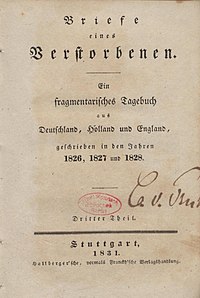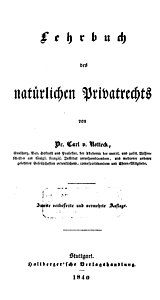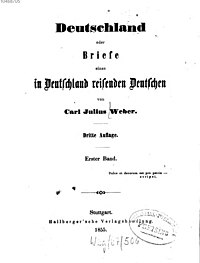Ludwig Hallberger
Ludwig Hallberger , called Louis Hallberger (born November 16, 1796 in Plochingen , † June 9, 1879 in Stuttgart ) was a German bookseller and publisher. In 1831 he founded Hallberger'sche Verlagbuchhandlung, which was one of the most important in Germany in the 1930s and 1940s.
In 1848 his son Eduard Hallberger founded a publishing company that became very successful with illustrated magazines and magnificent picture books. In 1873 the Hallberger publishing bookstore merged with the Eduard Hallberger publishing company, from which the Deutsche Verlags-Anstalt emerged in 1881 .
Life
Ludwig Wilhelm Friedrich Hallberger, called "Louis", was born in Plochingen on November 16, 1796 as the son of the wealthy Plochingen merchant Gottlieb Friedrich Hallberger. He learned the trade of merchant from the French-born Stuttgart cloth merchant Georg Friedrich Barrier (1770 – after 1810), who owned the house at Königstrasse 54 and ran his business there. For several years he worked as a traveling salesman for Barrier and at the end of 1819 acquired Stuttgart citizenship. At the beginning of 1820 he married Henriette Barrier, the daughter of his teacher, and as his son-in-law also became his business partner. The marriage had three children:
- Friedrich von Hallberger (1820-1892), senior tribunal councilor.
- Eduard Hallberger (1822–1880), he founded the Eduard Hallberger publishing house in 1848, which after his death in 1881 was converted into the Deutsche Verlags-Anstalt.
- Karl von Hallberger (1823–1890), from 1881 general director of the Deutsche Verlags-Anstalt.
|
|
Hallberger's wife died after less than four years of marriage in 1823 after the birth of their third child. Hallberger returned his share of his father-in-law's business and founded a textile wholesaler. In 1827 he took part in the Brodhag'schen Buchhandlung, whose founders were Friedrich Brodhag and the brothers Friedrich Gottlob Franckh and Johann Friedrich Franckh. The Franckh brothers had taken over part of the Franckh publishing house in the new company. From 1829 Hallberger learned the profession of publisher from his friend Paul Neff . In 1830 he ended his connection with the Brodhag'sche Buchhandlung and in September 1831 founded his own publishing house, the Hallberger'sche Verlagsbuchhandlung, which existed until the merger with his son Eduard's publishing company in 1873.
During the Second World War, all documents that could provide information about the economic success of Hallberger's publishing house were destroyed. In any case, when the publishing house was founded in 1831, Hallberger bought a large house in a prime location on Königstraße, probably with money from his wife, and in 1856 a house on Marstallstraße. He was soon able to set up a printing house, which in 1840 was the second largest in the area after Cotta'schen and which was taken over by his son in 1850. His publishing house survived the numerous start-ups and constant changes in the industry. He hardly took part in the magazine boom of the forties and fifties; he left that to his very successful son Eduard. In 1873 his publishing house merged with his son's publishing business.
Ernst Kelchner , a contemporary connoisseur of the publishing industry, said in Hallberger's death in 1879: “In the thirties and forties, the Hallberger publishing bookstore was one of the most important in Germany." The focal point of the belletristic movement was “.
After the death of his wife in 1823, Hallberger did not remarry. He died in Stuttgart on June 9, 1879 at the age of 82. A year later, his son Eduard von Hallberger died at the age of only 58. Both found their final resting place in the Hallberger mausoleum in the Prague cemetery in Stuttgart.
Publishing program
|
|
Hallberger took over some of his first authors from Franckh'schen Verlag, including his first bestselling authors: the now forgotten, then very popular entertainment writer Karl Spindler , 101 volumes of whom were published by Hallberger, and the brilliant landscape designer and brilliant travel writer Prince Hermann von Pückler-Muskau whose "Letters from a Deceased" sold well. Hallberger was later able to bind Nikolaus Lenau , a great poet of Weltschmerz like Lord Byron . Individual works by Ludwig Bechstein , Honoré de Balzac and Charles Dickens were also published by his publisher.
In its political textbook program, the publisher was not set on any particular direction. Hallberger, for example, published a revealing, 12-volume satirical work by the writer Karl Julius Weber and also published works by completely contrary authors. He published two literary stories, one by Heinrich Laube , a representative of Junge Deutschland , and one by Wolfgang Menzel , an aggressive opponent of Junge Deutschland. He has published political works by authors as diverse as Friedrich von Gentz , an advocate of the conservative-legitimist principle, and Karl von Rotteck , a leading exponent of radical liberalism.
Residential and commercial buildings
|
|
|
Louis Hallberger's first own residential and commercial building was at Königstrasse 3 in Stuttgart, in a prime location between the Königstor , the Marstall, the St. Eberhardskirche , the theater and the Schlossplatz. His son Eduard Hallberger founded his own publishing company in 1848 and also had his place of residence and business in his father's house at Königstrasse 3 until he moved into his own building at Königstrasse 18 in 1857. In 1856, Louis Hallberger bought the building at Marstallstrasse 2 next to his house on the corner as a residential building, and he kept the house at Königstrasse 3 as the publishing house.
From the memoirs of the writer Friedrich Wilhelm Hackländer it emerges that Hallberger also rented apartments in the large house at Königstrasse 3:
- "So the day of departure approached, on which the Prince Hugo Hohenlohe, master of the 'bell', held a solenne farewell party in his apartment, which was then in the house of the bookseller L. Hallberger." - The Gocke was from Stuttgart Artists' association that Hackländer co-founded. It also belonged to Crown Prince Karl , in whose honor there was a farewell ceremony in November 1843 before he set off on a trip to Italy with his private secretary Hackländer.
- After his dismissal as private secretary in 1849, Hackländer initially found “two rooms in the house of the bookseller L. Hallberger on Koenigsstrasse, quite suitable for me, since the house and location was one of the most elegant in Stuttgart and I was not allowed to give my enemies the pleasure of somewhere in to move the third floor of a side street ”.
Hallberger mausoleum
|
|
|
In 1875/1876 the Hallberger family had the architect Adolf Gnauth build a monumental, classical mausoleum in section 8 of the Prague cemetery . According to the inscriptions, Louis Hallberger († 1879) and his son Eduard Hallberger († 1880) rest in the mausoleum.
The mausoleum is modeled on an ancient temple. It rises about 15 meters (excluding the roof figure) over a base area of 13 by 9 meters. The front is structured by an open portal and two flanking open windows. The portal is framed by two Ionic columns and crowned by a triangular gable. The lateral closure is formed by two broad pillars, which, like the window parapets, have reliefs with symbols of mourning. Above a meander frieze with the inscription "Family Hallberger" the building is crowned by a projecting entablature. On the roof, the figure of a seated mourners rises above a two-step platform.
Two side staircases lead to the interior of the mausoleum with a stone bench in the middle and 4 empty figure niches on each side. Horizontal meander bands and a painted ornamental frieze as a top finish decorate the walls. Two flights of stairs in front of the mausoleum lead down to the basement where the remains of the deceased are located. The site of the mausoleum is overgrown with ground cover and is closed on the front by a massive iron bar grating, on the other sides by a wrought iron, richly ornamented fence. The mausoleum was restored in 1981 with funds from the Hallberger Foundation. In 2018, some panels of the fence had broken off and other parts of the fence had rusted.
Of the three large mausoleums in Stuttgart, the Hallberger mausoleum is the largest, the other two are the mausoleum of the Sauters and Entress-Fürsteneck family in Department 1 at the Prague cemetery and the Benckendorff mausoleum at the Heslach cemetery. Mausoleums of this size are the exception in Stuttgart because the builders feared they would contradict the proverbial Swabian thrift and modesty.
Honors
- 1985: The Deutsche Verlags-Anstalt donated a memorial plaque for Louis Hallberger in 1985, which was attached to the house at Königstrasse 5 (the house actually belonged to his son Eduard Hallberger, while the house at Königstrasse 3 belonged to him). Since the house at Königstraße 5 was replaced by a new building, the memorial plaque has disappeared.
literature
- Memorial plaques. In: Official Gazette of the City of Stuttgart, December 10, 1987.
- Felix Berner: The Hallberger publishing family. Founder of the Deutsche Verlags-Anstalt. In: Life pictures from Swabia and Franconia, Volume 15. Stuttgart: Kohlhammer, 1983, pages 280-315.
- Felix Berner: Louis and Eduard Hallberger: the founders of the Deutsche Verlags-Anstalt. Stuttgart: Deutsche Verlags-Anstalt, 1985. Revised reprint of #Berner 1983 , extended by numerous images.
- Gert Hagelweide: Literature for the German-language press: a bibliography; from the beginnings to 1970. Volume 11: 110926-124562: Biographische Literatur F - H. Munich: Saur, 2001, page 248.
- Ernst Kelchner : Hallberger, Ludwig Wilhelm Friedrich . In: Allgemeine Deutsche Biographie (ADB). Volume 10, Duncker & Humblot, Leipzig 1879, p. 418.
- Walther Killy (editor): Deutsche Biographische Enzyklopädie , Vol. 4, Pages 344-345.
- Hermann Vietzen: Hallberger, Eduard v .. In: New German Biography (NDB). Volume 7, Duncker & Humblot, Berlin 1966, ISBN 3-428-00188-5 , p. 539 ( digitized version ).
- Gustav Wais : Founding and development of the Deutsche Verlags-Anstalt. The great work of Eduard Hallberger and his successors. It is impossible to imagine the history of Stuttgart as a city of publishing houses without it. In: Stuttgarter Zeitung, number 217, September 20, 1958, page 35.
Web links
Footnotes
- ↑ Stuttgart address books, # Vietzen 1966 .
- ↑ # Vietzen 1966 .
- ↑ #Berner 1983 , pp. 13-14.
- ↑ #Berner 1983 , pages 24-25.
- ↑ # Kelchner 1879 .
- ↑ #Berner 1983 , page 20.
- ↑ #Berner 1983 , pages 15-24.
- ↑ Stuttgart address books, #Wais 1958.1 .
- ↑ Friedrich Hackländer: The novel of my life. Volume 1. Stuttgart: Krabbe, 1878, page 302.
- ↑ Friedrich Hackländer: The novel of my life. Volume 2. Stuttgart: Krabbe, 1878, page 246.
- ↑ # Official Journal 1987 .
| personal data | |
|---|---|
| SURNAME | Hallberger, Ludwig |
| ALTERNATIVE NAMES | Hallberger, Ludwig Wilhelm Friedrich (full name); Hallberger, Louis (nickname) |
| BRIEF DESCRIPTION | German bookseller and publisher |
| DATE OF BIRTH | November 16, 1796 |
| PLACE OF BIRTH | Plochingen |
| DATE OF DEATH | June 9, 1879 |
| Place of death | Stuttgart |











